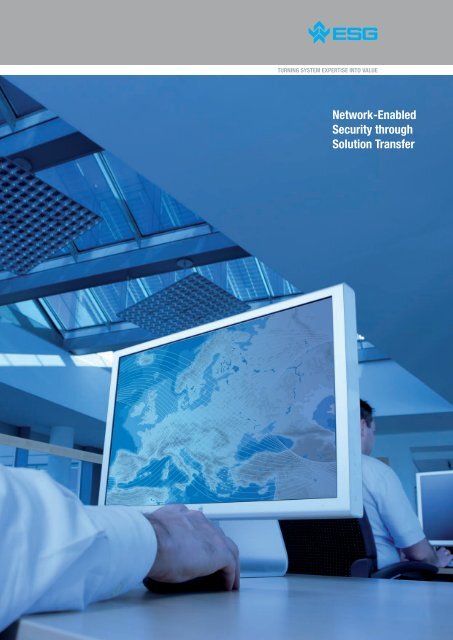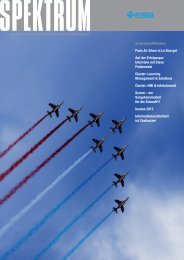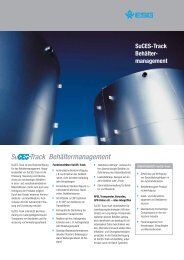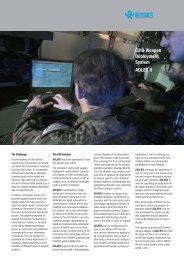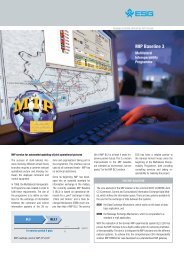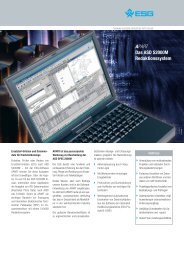Network-Enabled Security through Solution Transfer - ESG
Network-Enabled Security through Solution Transfer - ESG
Network-Enabled Security through Solution Transfer - ESG
Create successful ePaper yourself
Turn your PDF publications into a flip-book with our unique Google optimized e-Paper software.
TURNING SYSTEM EXPERTISE INTO VALUE<br />
<strong>Network</strong>-<strong>Enabled</strong><br />
<strong>Security</strong> <strong>through</strong><br />
<strong>Solution</strong> <strong>Transfer</strong>
<strong>Network</strong>-Centric Operations<br />
Threats and related security policies have changed dramatically and, as a consequence,<br />
initiated a continuous transformation of military forces. The vision<br />
of <strong>Network</strong>-Centric Operations (NCO) is a core element of this transformation<br />
process.<br />
NCO is a military doctrine which seeks to translate an information advantage,<br />
enabled in part by information technology, into a competitive war-fighting advantage<br />
<strong>through</strong> the robust networking of well-informed geographically dispersed<br />
forces. The four tenets of NCO (reference: DoD, Washington, 2005) are:<br />
A robustly networked force improves information sharing; Information sharing<br />
enhances the quality of information and shared situational awareness; Shared<br />
situational awareness enables collaboration and self-synchronisation; These,<br />
in turn, dramatically increase mission effectiveness.<br />
<strong>ESG</strong> plays a leading role in helping the German Armed Forces to achieve NCO.<br />
We are main contractor and lead system integrator for the first stage of the<br />
further development of the national Joint Command, Control & Information System<br />
(FüInfoSysSK) and have system responsibility for the operation and further<br />
development of the national 24/7 COMINT core system. At an international<br />
level, <strong>ESG</strong> is responsible for the development of the German realisation of the<br />
Multilateral Interoperability Programme (MIP) interface and we have conducted<br />
various projects for the European Defence Agency concerning architectures for<br />
EU civil and military operations.<br />
J O I N T – M U LT I N A T I O N A L – N E T W O R K E D<br />
System Integration<br />
<strong>Network</strong>ing – combined with changes in technology, organisation, processes and<br />
people – allows new forms of organisational behaviour. Therefore the interoperability<br />
of different Command & Control, Communication, Computer and Information<br />
(C4I) systems is essential, closely connected with substantial integration<br />
efforts. However, the required cross-system interoperability is usually not the<br />
focus of system providers.<br />
<strong>ESG</strong> is a leading, international system and software company for development<br />
and service processes of software-intensive, complex, high-tech, security-relevant<br />
solutions. We have extensive expertise and many years of experience in the<br />
design, development, integration and support of IT and electronic systems across<br />
different industries.<br />
In the field of intelligence and surveillance, we develop customer-specific IT systems<br />
for Signals Intelligence (SIGINT), Communications Intelligence (COMINT),<br />
Open Source Intelligence (OSINT), Imagery Intelligence (IMINT) and Geospatial<br />
Intelligence (GEOINT). We provide cross-functional IT solutions for processing<br />
and provisioning geospatial information. We use our extensive know-how in the<br />
development and integration of high performance, interoperable, command &<br />
control and tactical deployment systems. <strong>Solution</strong>s and services for fundamental<br />
areas such as IT security and communication are also part of our portfolio.<br />
Support<br />
Logistics<br />
Communication<br />
Information & IT security<br />
Human-system integration<br />
Intelligence, Surveillance<br />
& Reconnaissance<br />
<strong>Network</strong>ing of ISR means<br />
Information fusion & joint evaluation<br />
Threat analysis<br />
Common relevant operational picture<br />
Effect<br />
Command & Control<br />
<strong>Network</strong>ing<br />
at tactical level<br />
Interoperability<br />
of C2 systems<br />
S O L U T I O N
Effect<br />
Management<br />
<strong>Network</strong>ing<br />
at operational/tactical<br />
& strategic level<br />
Interoperability<br />
of C2 systems<br />
Situation Monitoring & Risk Analysis<br />
Inter-agency networking<br />
of information sources<br />
Information fusion & joint evaluation<br />
Risk analysis & trends<br />
Shared situational picture at local, national & EU level<br />
T R A N S F E R<br />
Support<br />
Logistics<br />
Communication<br />
Information & IT security<br />
Human-system integration<br />
<strong>Network</strong>-<strong>Enabled</strong> <strong>Security</strong><br />
Current and future threats are no longer only of a military nature. Proliferation,<br />
organised crime and illegal migration are part of today’s complex security risk<br />
scenario. No single national organisation or even a state can effectively control<br />
such risks.<br />
<strong>Network</strong>-enabled security means the capability for common, national and international,<br />
security-related prevention <strong>through</strong> multilateral coordination and<br />
cooperation between institutions, organisations and administration. In analogy<br />
to the military sector, information superiority is also a core element of networkenabled<br />
security in the context of intelligence, command & control, and operations.<br />
All stakeholders and co-operants share a common situational picture<br />
based on situational awareness. Exchange of information enables the co-operants<br />
to operate effectively and improves operational and reaction capability.<br />
At the European level, <strong>ESG</strong> is a leading provider of network-enabled security<br />
and integrated border management solutions. We are main contractor for the<br />
Technical Feasibility Study European Surveillance (EUROSUR), consultant to the<br />
European agency Frontex, and partner to the European Defence Agency (EDA)<br />
for its Maritime Surveillance project (MARSUR). We have also developed a command<br />
and control system for highly mobile mission forces (TARANISmobile). At<br />
national level, <strong>ESG</strong> is main contractor for the implementation of the automatic<br />
vessel identification system (AIS – German Coast).<br />
I N T E R - A G E N C Y – C R O S S - S T AT E – N E T W O R K E D<br />
<strong>Solution</strong> <strong>Transfer</strong> Defence <strong>Security</strong><br />
Both visions – <strong>Network</strong>-Centric Operations and <strong>Network</strong>-<strong>Enabled</strong> <strong>Security</strong> –<br />
aim to integrate and synchronise all appropriate capabilities to improve situational<br />
awareness, enhance response capability and finally to increase operation<br />
effectiveness. The terminologies are different, but the challenges faced and<br />
technologies required are nearly identical. Independent with regard to hardware<br />
manufacturers and solution providers, <strong>ESG</strong> accomplishes a technology<br />
solution transfer between the defence and security markets, creating synergies<br />
and significant added-value for our customers at a minimum level of risk.<br />
ADVANTAGES PROVIDED bY <strong>ESG</strong><br />
Dedicated transfer of solutions from the defence to the civil market<br />
and vice versa<br />
Independent from hardware manufacturers<br />
Excellent competence in the integration of complex and security-relevant<br />
systems<br />
Partnership and support <strong>through</strong>out the entire system lifecycle<br />
High degree of coverage across fundamental support areas with<br />
comprehensive capabilities and existing solution modules
References<br />
EUROSUR: European Surveillance<br />
The “Technical study for the development of concepts for a border surveillance<br />
infrastructure, a secure communication network and a pre-frontier<br />
intelligence picture of the border within the framework of a European border<br />
surveillance system” was carried out by <strong>ESG</strong> as main contractor for<br />
the Directorate-General for Justice, Freedom and <strong>Security</strong> of the European<br />
Commission in 2009. The study provides all necessary concepts, system<br />
and technical specifications and cost estimates for setting up national surveillance<br />
systems at land and sea borders, taking into consideration modern<br />
technologies and standards or for expanding already existing systems.<br />
In addition, new National Coordination Centres (NCCs) in the member states<br />
are to be developed and systematically networked. The previously heterogeneous,<br />
national activities of the various involved authorities (customs, police,<br />
border police, coastguard, military) are to be united under the umbrella<br />
of respective joint (national) coordination centres. The NCCs and the EU authority<br />
Frontex will be networked via a new, secure communication network.<br />
This integrated approach will enable the generation of the first-ever joint<br />
situation picture at EU level and also improve reaction capability.<br />
Furthermore, the architecture for a “Common Prefrontier Intelligence Picture”<br />
(CPIP) was designed as part of the study. The aim is to identify at<br />
an early stage new migration trends, risks and threats for the EU external<br />
borders <strong>through</strong>, for example, the evaluation of Open Source Intelligence<br />
(OSINT) and Imagery Intelligence (IMINT).<br />
Marsur: Maritime Surveillance<br />
The European Defence Agency (EDA) has set up a working group on the subject<br />
of maritime surveillance networking with the aim of developing a solution that<br />
fulfils the need for a coherent commonly-recognised maritime picture (RMP).<br />
For this purpose, EDA has contracted two studies. The first study regards the<br />
Marsur architecture and the second – currently being carried out by <strong>ESG</strong> and<br />
the Spanish company gmv – is concerned with Marsur netwoking interface requirements.<br />
This study will develop the technical specification for the Marsur<br />
eXchange System (MEXS) and prepare the deliverables for the demonstration<br />
phase.<br />
AIS – German Coast: Important contribution to maritime security<br />
The German Federal Waterways and Shipping Administration is currently setting<br />
up a new technology to monitor and control vessel traffic better and more<br />
efficiently: the “Automatic Identification System” (AIS). AIS helps to prevent collisions<br />
at sea and enables ships to exchange information with one another and<br />
with coastal Vessel Traffic Systems (VTS) centres. As main contractor for the<br />
project “AIS – German Coast”, <strong>ESG</strong> developed and integrated the software and<br />
put the entire system into operation.<br />
TARANISmobile: The highly mobile command & control system<br />
For highly mobile mission forces we have developed the solution TARANISmobile:<br />
a portable, mobile and compact command and control system that coordinates<br />
the resources and forces for information gathering, operation command<br />
and display of the situation and results. TARANISmobile is used to display,<br />
monitor the status of and manage military and civil mission forces (e.g. border<br />
security, fire brigade, police, emergency management). By using additional<br />
sensors (cameras, heat image equipment), further information (e.g. environmental<br />
data, positions) can be gathered, displayed, processed, saved and exchanged<br />
between participants.<br />
MESIS: Interactive exercise support<br />
The “Euro-Atlantic Disaster Response Coordination Centre” (EADRCC) in Brussels<br />
regularly practises the course of events for internationally coordinated<br />
rescue measures during catastrophes using the crisis management exercise<br />
system MESIS developed by <strong>ESG</strong>. MESIS is partly based on results from the<br />
large LüKEX exercises and on the complex requirements of distributed public<br />
security and civil protection authorities.<br />
<strong>ESG</strong> Elektroniksystem- und Logistik-GmbH4Livry-Gargan-Str. 6482256 Furstenfeldbruck, Germany4Phone +49 89 9216 - 04itk@esg.eu4www.esg.eu


